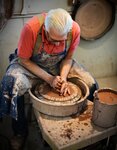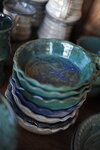



Enoughness. An alluring and elusive place/idea/illusion.
For most of us, we get ahold of it, rejoice, breathe, swear that never again will we want more, and then, in the tiniest instant of desire, ambition or just mere curiosity, falter and watch, with worn familiarity, as it slips away — again.
But not for everyone. Jim Trudeau understands enoughness. I dare say he came into the world wired this way. He is a breath of fresh air. And his work has made its way into many of our homes - and the homes of many - because of this exact and extraordinary quality.
Jim is an artist, a potter, living and working in Essex. He and his wife, Ann, own Wheelworks Pottery on Main Street where Jim makes pottery in a small studio, fires it as well, and then sells it in a small shop behind his home.
I remember the first time I came up Southern Avenue to the intersection at Main Street and saw the lovely yellow house with an “Open” flag outside and the words “pottery studio” somewhere in the mix. I could not wait to stop by. A quintessential Essex experience, it was hit or miss in terms of being open, but when it was, I parked and then opened the gate as the cheery sign saying, “Come on in!” encouraged me to do (even though I felt slightly as if I was sneaking into someone’s backyard). And there, actually in someone’s back yard, was a little house filled with the most wonderful handmade pottery.
To get to this marvelous trove, I passed through the garden, in full bloom. As I admired the flowers, a woman called from the house - “Coming! …” This would be Ann, Jim’s lovely wife, who helped me. Jim was in his studio throwing pots. I left high on the delightful and quirky sweetness of it all, with a beautiful large bowl that sits on my kitchen counter as I write this.
Pottery found Jim later in life. He had gone to school for electrical engineering. However, the anti-war movement had influenced his attitude, and looking ahead, nearly all of the jobs available at the time were in defense. Uncertain as to how to recalibrate, he dropped out of school and moved to Washington to hike and backpack the Olympic peninsula. In 1975 he took his first pottery class using a potter’s wheel and “throwing” pots.
Previously he had only worked at what is called “handbuilding”, just making pieces with your hands and not on a potter’s wheel. In 1976 he decided to return to school pursuing a major in horticulture, but pottery was in the back of his mind. By the end of his first semester pottery had taken him completely, and he changed his major to fine arts. He studied with Patrick Siler, a young potter who had studied under the famous artist Peter Voulkus.
Prior to 1950, Jim explained, pottery was a cottage industry. But in the late 50s and early 60s potters began elevating their work, populating galleries and museums. Peter Voulkos, a potter working in California, began pushing the limits of pottery giving way to the California Funk Movement; making ceramics that were not always functional, but simply art. Jim studied with Patrick for four years. He then attended graduate school at Ohio State to determine if teaching was something he might be interested in; it wasn’t. Furthermore, he found himself surrounded by artists with whom he was out of concert. There was an egoism that prevailed in many of the art circles which did not suit Jim.
From this experience came the clarity that he wanted to work in the studio - by himself. He would make pottery that could be used every day. It would be affordable. He wanted to be the village potter.
Wheelworks pottery opened its doors in 2010 and Jim Trudeau became the village potter of Essex. When you visit, which you should, you will note that Jim has chosen to work within a rather narrow color palette. Earthy rich greens and blues. He explains that glazing is the most difficult part of making ceramics. It takes a long time and can have all kinds of technical issues. Fit, texture, shrinking, daunting (cracks that occur as pieces cool down after firing), crazing (a network of fine cracks that can appear on the surface) and more, unintentionally. He has perfected a glazing recipe of sorts that always works. He allows for creativity within this recipe, but rarely deviates from it. Despite what may seem like a limiting factor, Jim’s work is alive with creativity. It speaks to the natural world, suggesting water and moss. With patterns that have a biology. It feels organic.
Jim explained that there is general consensus that it takes seven years to become a potter. Mainly, or perhaps entirely, due to these issues of all that can go wrong. It takes seven years to wade through and understand them all enough so that you can begin making pottery as you wish. It is then that you can actually flow.
Jim cherishes flow. There was a period of his work when he was making pieces for the craft show circuit. During this time, he was producing between 40-100 pieces per day on his throwing days. He said that during this high production, he would find it - that flow - regularly. He describes it as having everything else melt away and just creating. He said it is very zen - and very special. I will say that there is something very peaceful and healthy about Jim. Just spending a bit of time with him in his studio one can imagine the serenity of his days alone throwing — and flowing.
When Jim speaks of the feel of clay and centering it on the wheel, he uses the potter’s term “getting out of round”, when the piece on the wheel gets off center. He notes, however, that clay has a memory. And will try to get back to its original shape.
Perhaps when we get out of round, when enoughness eludes us yet again, we can remember that, like clay, we have a memory of ourselves. And try to find our center. Jim Trudeau found his. And through it gives us pottery that is full of beauty and function, but in there too, is an understanding — of flow, of enoughness, and what it means to be the village potter.